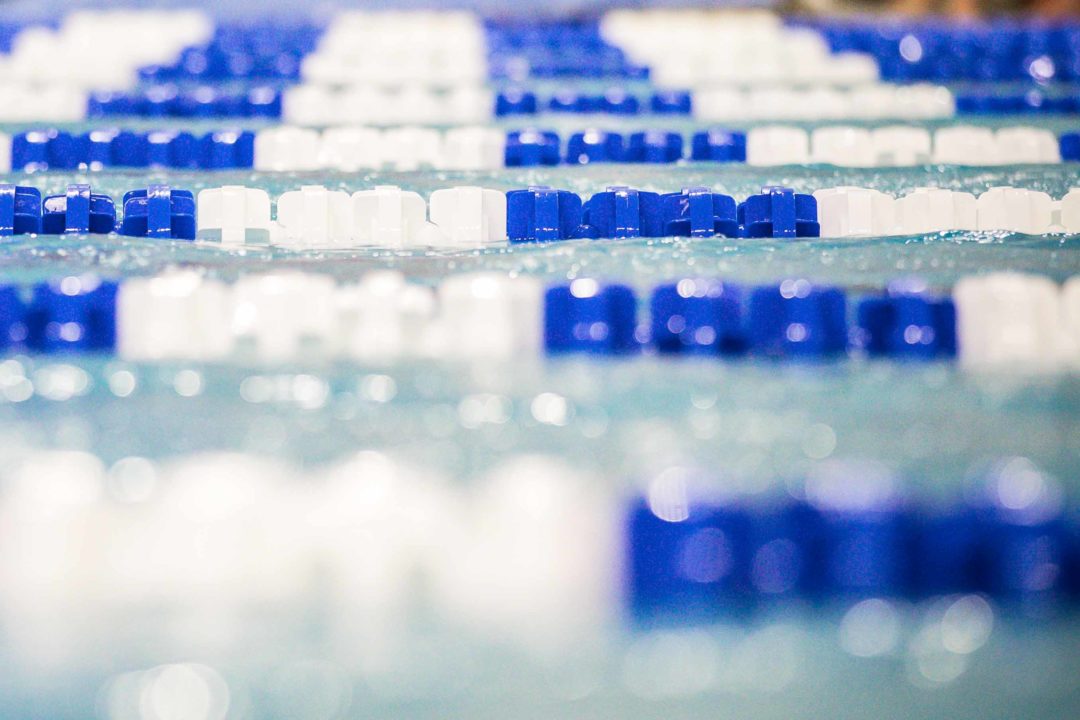It’s that time of year again. All of you college swimmers are in the thick of the semester; staying on top of your class assignments, continuing to slay daily practice and spending hours on coach buses travelling to meets. Before you know it, you’ll be zipping up your suitcase and heading to a (hopefully) warm location for your training trip!
As a student athlete, you want to maintain your energy levels throughout the day in order to crush a grueling workout and apply yourself in the classroom. Being a former college swimmer myself, I remember the struggle of balancing it all. I can admit that in my years as an underclassman, I failed to prioritize my nutrition and was not fueling myself properly. However, I soon learned the importance of eating right, staying hydrated and getting adequate rest. I discovered which foods worked best for me as well as the timeline of my meals. As I developed a meal routine and stuck with it, I noticed that my energy levels improved and I had this feeling of mental clarity. Because of this, I was able to crush a morning workout and continue through the day with enough energy to focus on my academic responsibilities.
Feeling both nostalgic and sympathetic toward fellow student athletes during this chaotic time of the season, I dug into the archives to show you what my typical day of eating looked like as a college swimmer. This day of eating is by no means perfect however, it can provide you with some direction if you are feeling lost in navigating the dining hall and are looking for some meal inspiration. Since these meals are simple to make and don’t require many ingredients, you should be able to recreate them in any dining hall or in your kitchen at home.
7:45 Pre-Morning Practice Fuel:
I’ve always had difficulty getting in a big meal before a morning workout. While I could (sometimes) get away with swimming on an empty stomach, I typically reached for a quick bar or a banana with a spoonful of nut butter. My favorite brands were Kind, Clif and Larabars. I highly recommend the Peanut Butter Chocolate Chip Larabar as a pre-practice snack.

10:30 Post Practice Breakfast:
My go to, dining hall breakfast after a 2 hour pool workout was oatmeal. Oatmeal is a great option; not only does it contain necessary carbohydrates for refueling, but because there are so many possible topping combinations. Oatmeal doesn’t have to be boring! I may be biased because I have a nut butter obsession, but I love topping my oats with either peanut butter or almond butter and fruit. With the sweetness from the fruit, I never add sugar to my oatmeal. I also avoid pre-sweetened, flavored oatmeal packs because of the absurd amount of added sugar. If possible, choose an unsweetened oatmeal option in your dining hall or bring a packet of unsweetened oatmeal with you! For this bowl, I added a handful of blueberries, a dollop of almond butter and a sprinkle of sliced almonds for some added texture. On the side, I also had 2 hard boiled eggs. Based on your own dietary preference, this is completely optional however, I find that some additional protein keeps me full throughout the morning. In addition to my breakfast, I drank 32 oz of water from my water bottle (I carried a Hydro Flask with me at all times!) and had 2 cups of coffee with a splash of almond milk.
1:30 Lunch
For lunch, I typically went for a big plate full of vegetables, lean protein and whole grains. I loved recreating my typical burrito bowl order. First, start with a base of greens, add some roasted veggies, I went with zucchini and squash, a scoop of brown rice, black beans, chicken and pico de gallo salsa. Whether you are vegan or vegetarian, you can sub the chicken for tofu or just include the beans. I like having a balanced lunch because it keeps me feeling fueled and satiated well into the afternoon. Just as with breakfast, I continued to drink from my water bottle with this meal.
Pro tip: Add a dollop of fat free Greek yogurt instead of sour cream!

4:00 Snack: In between lunch and dinner, I’d usually have a small snack in between classes or while I was doing work in the library. I usually grabbed a piece of fruit. My favorites were honey crisp apples, oranges or pears.

6:30 Dinner: I am definitely a creature of habit, so most likely, my dinner consisted of a meal very similar to my lunch: a bowl or plate of veggies and some lean protein. For this meal, I had pesto chickpea pasta with roasted broccoli and garlic over a bed of spinach. You could also add some chicken or fish for additional protein. If you wish to recreate this meal in a dining hall, start by filling half a bowl or plate with greens, add in a scoop of whole wheat pasta and load up on whatever vegetables are available. If there aren’t any roasted or cooked vegetable options, you can take a microwave safe bowl, add veggies from the salad bar and a tiny bit of water then microwave for up to a minute to steam the veggies. As for a drink, I would have water or flavored seltzer.
8:00 Dessert: Some nights, I needed something to power me through an evening in the library or just work at home. My go to sweet (but smart) dessert was greek yogurt, fruit and sometimes, nut butter. For this bowl, I used plain, fat-free greek yogurt, stirred in some cinnamon, added sliced banana and a spoonful of almond butter (I love this stuff if you can’t tell!). You guessed it, I’m still sipping on my water bottle. Throughout the day, I would probably have over 100 oz of water, refilling my Hydro Flask anywhere from 3-5 times a day. I cannot stress how important hydration is, especially as a student athlete!
Check out my page for more recipe inspiration and be sure to share your student athl-eats with me @whatzoeeeats.
About Zoe Gregorace





Not cool. This barely adds up to 2,400 kilocalories per day. Nearly every reputable study of the total energy expenditure of female college-level swimmers puts their baseline energy needs about 400 calories higher (2622 – 2886 kc/day). That is for EASY days. INTENSE training requires that female swimmers eat 4,000-5,500 calories a day. Those numbers come from the most rigorous studies, using the doubly-labeled water method.
The eating plan in this article is suitable for sedentary middle-aged office workers. But for a college-level swimmer, this is a crash diet. And crash diets hurt swimmers. They correlate with eating disorders, organ damage, and lifelong skeletal deficiencies. See the most recent consensus statement on Nutrition and Athletic Performance from the American… Read more »
WOW you’re making awfully huge leaps and making massive accusations without knowing how tall Zoe is, what the portion size of the meals are, or what kind of training she was doing.
Maybe next time before you spout off these kind of “you’re ruining the world” accusations at someone who, by the way, is studying at one of the best nutrition programs in the country, you should ask some clarifying questions first? No? You’re right. Shoot first, ask questions later.
Yeah, I don’t love the tone I took on this. I could have been more civil. I got worked up about it. Not an excuse. I think the author is trying to convey the current thinking on nutrition to a wider audience. Me being a jerk about it doesn’t advance the debate.
My irritation is when nutritionists give this advice in a swimming forum and do not explicitly say – ‘hey if you are swimming at an elite level, or NCAA, normal nutritional advice does not apply to you.’
There are really good sources for nutritional information for athletic performance. The ACSM report I mentioned is terrific. It gives a totally different impression of nutritional needs for athletes than… Read more »
I mean, the tone of the comment is a little harsh. but this article does come across as mostly diet advice. maybe a less strident tone from commentators, along with a little more attention from nutrition writers to women’s health issues. and Shy, ok. but is the author just sharing personal information or is this intended as nutritional guidance for swimmers? i think it is intended as guidance. so not saying more about portions, that’s something the author should have done.
Hi all, just to clarify the purpose of Zoe’s column: she’s not trying to give specific nutritional advice to any one athlete, because the needs of each athlete in terms of caloric intake will vary significantly from swimmer to swimmer. In fact, we specifically are steering clear of anything focused on ‘calories’ in this series.
The goal of Zoe’s ongoing series is to provide athletes with ideas for the kind of balanced nutritional meals that they should be eating to receive the right nutrients that they need for top performance.
When I was a swimmer, our “after school meal,” which we definitely needed because we were a pretty high-volume training group, was “Wendy’s double cheeseburgers and a large fry.” So,… Read more »
Thank you for your thoughtful response. I think a column that directly addresses the question of ‘what should my swimmer eat?’ would be really valuable. I would only hope that – as a change of pace from what is found on the USA Swimming site – the answers are not more of this high-fiber, low-fat dieting advice. Again, ACSM and the Academy of Nutrition and Dietetics is a great place to start. They acknowledge that the first answer to that question – ‘what should my swimmer eat’ – is almost always ‘more food.’
I hope we get to a place where adults stop telling teen athletes that there’s something wrong with eating a fast-food double cheeseburger and fries. If fast-food is what is available, then eat it. You have to get enough to eat if you want to compete (hey!). You can always aim to include more variety in your meals, and that can be avocado toast sometimes. But if it has to be chicken nuggets, then eat chicken nuggets. Someone already pointed out that the great crop of current swimmers did not grow up eating at the organic food co-op. Why can’t we admit that?
Yeah, I mean, everything in moderation, right? But this was like…4 times a week. At least. Sometimes we’d go back for dinner.
Thanks for sharing some great tips and ideas. Would have also liked to see a mention of meeting with a registered dietitian to address any general or specific performance and/or nutrient needs. There is too much misinformation about nutrition and it is important to get the correct information from a nutrition professional.
interested in hearing a dude diet.
Ryan Lochte 2008 Olympics diet- I ate McDonald’s 3-4 times a day, still beat the greatest backstroker ever at his best event
Great and informative article! Thank you for posting this! I’m vegetarian and your advice can help me navigate the tough season ahead!
What college program did you go to that allows you to eat breakfast before practice at 7:45?
That’s when most are eating their post swim breakfast
Tufts. It’s right there in her bio…